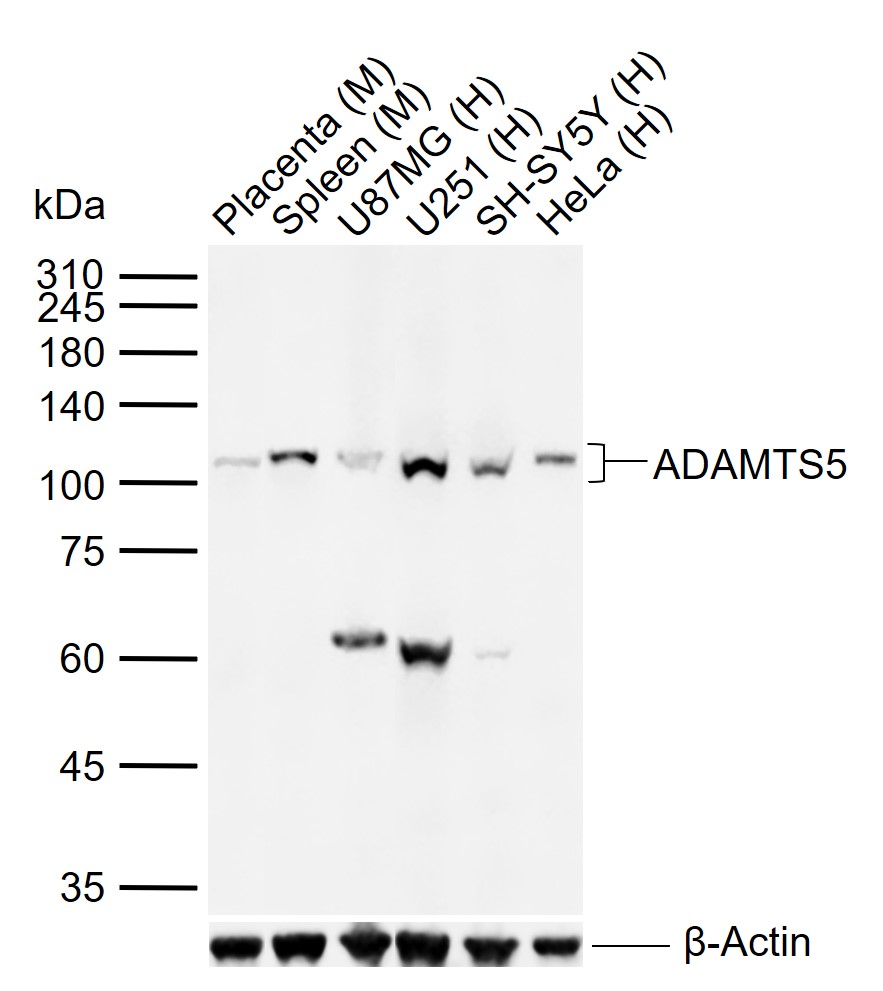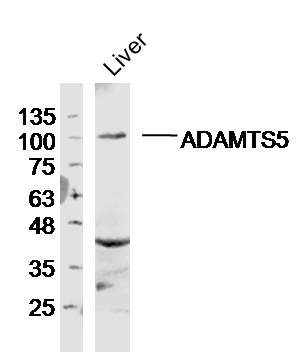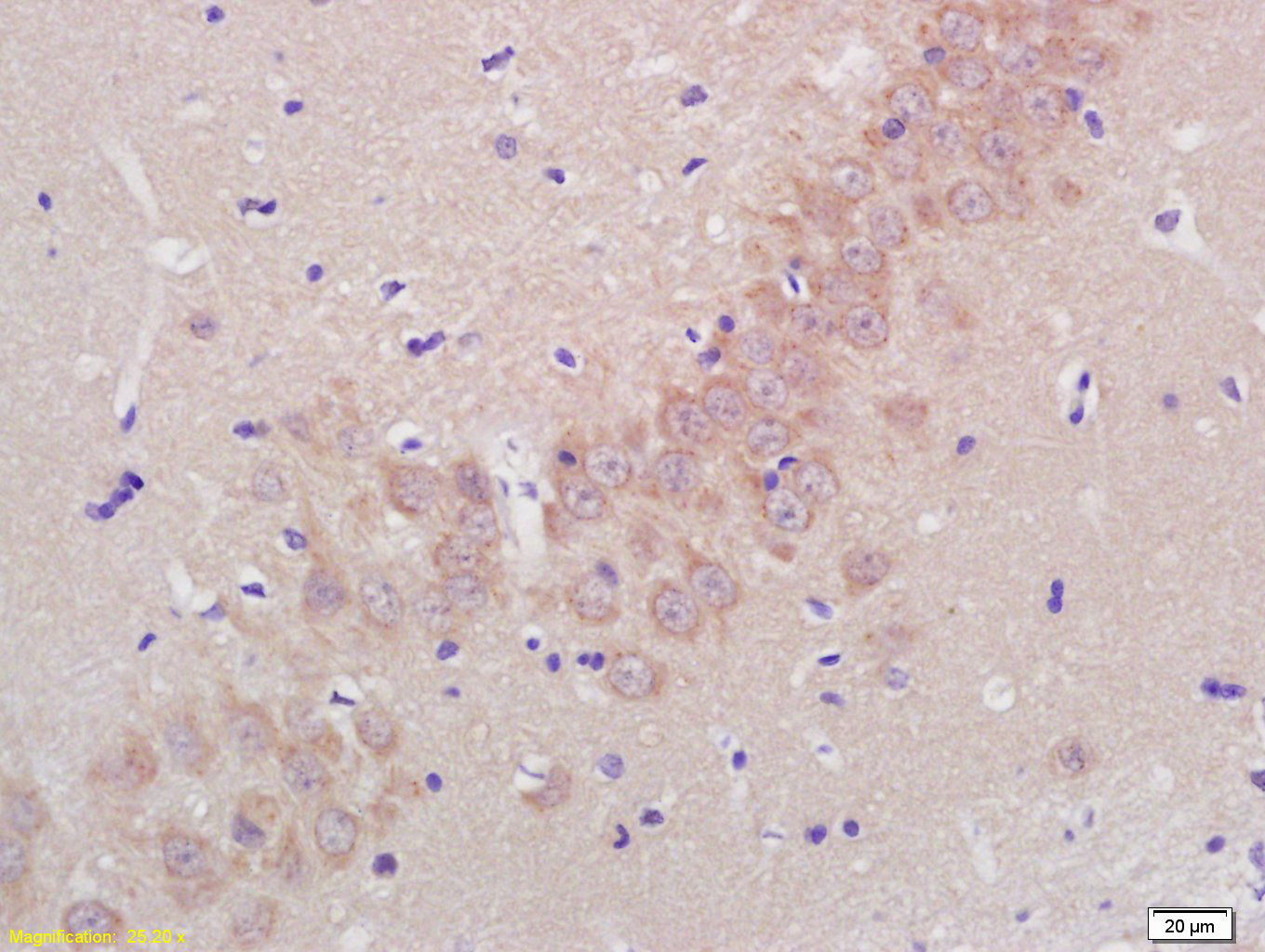
Rabbit Anti-ADAMTS5 antibody
A disintegrin and metalloproteinase with thrombospondin motifs 5; A disintegrin like and metalloprotease (reprolysin type) with thrombospondin type 1 motif 5; A Disintigrin And Metalloproteinase with ThromboSpondin motif-5; ADAM metallopeptidase with thro
View History [Clear]
Details
Product Name ADAMTS5 Chinese Name 软骨蛋白聚糖抗体 Alias A disintegrin and metalloproteinase with thrombospondin motifs 5; A disintegrin like and metalloprotease (reprolysin type) with thrombospondin type 1 motif 5; A Disintigrin And Metalloproteinase with ThromboSpondin motif-5; ADAM metallopeptidase with thrombospondin type 1 motif 5; ADAM TS 11; ADAM TS 5; ADAM TS5; ADAMTS 11; ADAMTS 5; ADAMTS11; ADMP 2; ADMP2; Aggrecanase 2; aggrecanase-2; FLJ36738; Implantin; ThromboSpondin motif-5. literatures Research Area Tumour immunology Kinases and Phosphatases Immunogen Species Rabbit Clonality Polyclonal React Species Human, Mouse, Rat, (predicted: Dog, Pig, Cow, Horse, Rabbit, ) Applications WB=1:500-2000 ELISA=1:5000-10000 IHC-P=1:100-500 (Paraffin sections need antigen repair)
not yet tested in other applications.
optimal dilutions/concentrations should be determined by the end user.Theoretical molecular weight 102kDa Cellular localization The nucleus cytoplasmic Form Liquid Concentration 1mg/ml immunogen KLH conjugated synthetic peptide derived from human ADAMTS5: 511-610/930 Lsotype IgG Purification affinity purified by Protein A Buffer Solution 0.01M TBS(pH7.4) with 1% BSA, 0.03% Proclin300 and 50% Glycerol. Storage Shipped at 4℃. Store at -20 °C for one year. Avoid repeated freeze/thaw cycles. Attention This product as supplied is intended for research use only, not for use in human, therapeutic or diagnostic applications. PubMed PubMed Product Detail ADAMTS5 was first described as ADAMTS5, a protein elevated in mice during the peri-implantion period. At the same time, another group identified Aggrecanase 11, a protein elevated in arthritic synovium. The name was later changed to ADAMTS5. ADAMTS5 is expressed in human and mouse. It has been found in heart, lung, cervix, uterus, ovary, brain, cartilage, and numerous other tissues, as well as chondroblastoma cell lines. Initial observations indicated a role for ADAMTS5 in aggrecan cleavage and cartilage destruction, especially in arthritis, and potentially a role in embryo implantation. ADAMTS5 contains the canonical HExxHxxxxxH zinc metalloproteinase motif, and has been shown to efficiently cleave Aggrecan. In addition to the metalloprotease domain, ADAMTS5 has a propeptide domain, a prohormone convertase (PC, furin) cleavage site, a cysteine-rich domain, a spacer domain, and two thrombospondin-1 like domains. ADAMTS5 is inhibited by the endogenous MMP inhibitors (TIMP1, 2, 3, and 4) but most efficiently by TIMP3. Unlike many of the ADAMs proteases, ADAMTS5 does not have a transmembrane domain, and is a secreted protein. Full length ADAMTS5 is a 930 amino acid protein with a predicted molecular mass is 101.7 kDa, but glycosylation and the abundance of cysteine residues gives ADAMTS5 a greater apparent molecular weight on reduced SDS PAGE gels. When ADAMTS5 is secreted, it is cleaved at the furin cleavage site (predicted molecular mass 73.2 kDa) and then further cleaved to generate a range of smaller forms.
Function:
Cleaves aggrecan, a cartilage proteoglycan, and may be involved in its turnover. May play an important role in the destruction of aggrecan in arthritic diseases. May play a role in proteolytic processing mostly during the peri-implantation period.
Subcellular Location:
Secreted, extracellular space, extracellular matrix.
Tissue Specificity:
Expressed at low level in placenta primarily but also detected in heart and brain, cervix, uterus, bladder, esophagus, rib cartilage, chondroblastoma, fibrous tissue and a joint capsule from an arthritic patient.
Post-translational modifications:
The precursor is cleaved by a furin endopeptidase.
C- and O-glycosylated. O-fucosylated by POFUT2 on a serine or a threonine residue found within the consensus sequence C1-X(2)-(S/T)-C2-G of the TSP type-1 repeat domains where C1 and C2 are the first and second cysteine residue of the repeat, respectively. Fucosylated repeats can then be further glycosylated by the addition of a beta-1,3-glucose residue by the glucosyltransferase, B3GALTL. Fucosylation can mediate the efficient secretion of ADAMTS family members. Can be C-glycosylated with one or two mannose molecules on tryptophan residues within the consensus sequence W-X-X-W of the TPRs, and N-glycosylated. These other glycosylations can also facilitate secretion.
Glycosylated. Can be O-fucosylated by POFUT2 on a serine or a threonine residue found within the consensus sequence C1-X(2)-(S/T)-C2-G of the TSP type-1 repeat domains where C1 and C2 are the first and second cysteine residue of the repeat, respectively. Fucosylated repeats can then be further glycosylated by the addition of a beta-1,3-glucose residue by the glucosyltransferase, B3GALTL. Fucosylation mediates the efficient secretion of ADAMTS family members. Also can be C-glycosylated with one or two mannose molecules on tryptophan residues within the consensus sequence W-X-X-W of the TPRs, and N-glycosylated. These other glycosylations can also facilitate secretion.
Similarity:
Contains 1 disintegrin domain.
Contains 1 peptidase M12B domain.
Contains 2 TSP type-1 domains.
SWISS:
Q9UNA0
Gene ID:
11096
Database links:Entrez Gene: 11096 Human
Entrez Gene: 23794 Mouse
Omim: 605007 Human
SwissProt: Q9UNA0 Human
SwissProt: Q9R001 Mouse
Unigene: 58324 Human
Unigene: 112933 Mouse
Product Picture
Lane 1: Mouse Placenta tissue lysates
Lane 2: Mouse Spleen tissue lysates
Lane 3: Human U87MG cell lysates
Lane 4: Human U251 cell lysates
Lane 5: Human SH-SY5Y cell lysates
Lane 6: Human HeLa cell lysates
Primary: Anti- ADAMTS5 (SL3573R) at 1/1000 dilution
Secondary: IRDye800CW Goat Anti-Rabbit IgG at 1/20000 dilution
Predicted band size: 102 kDa
Observed band size: 102 kDa
Sample:Liver(Mouse)Lysate at 40 ug
Primary: Anti-ADAMTS5(SL3573R)at 1/300 dilution
Secondary: IRDye800CW Goat Anti-Rabbit IgG at 1/20000 dilution
Predicted band size: 102 kD
Observed band size: 102 kD
Tissue/cell: rat brain tissue; 4% Paraformaldehyde-fixed and paraffin-embedded;
Antigen retrieval: citrate buffer ( 0.01M, pH 6.0 ), Boiling bathing for 15min; Block endogenous peroxidase by 3% Hydrogen peroxide for 30min; Blocking buffer (normal goat serum,C-0005) at 37℃ for 20 min;
Incubation: Anti-Aggrecanase-2/ADAMTS5 Polyclonal Antibody, Unconjugated(SL3573R) 1:200, overnight at 4°C, followed by conjugation to the secondary antibody(SP-0023) and DAB(C-0010) staining
References (0)
No References
Bought notes(bought amounts latest0)
No one bought this product
User Comment(Total0User Comment Num)
- No comment





 +86 571 56623320
+86 571 56623320
 +86 18668110335
+86 18668110335

